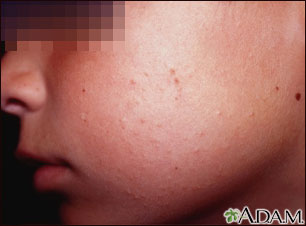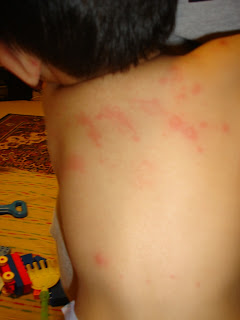Food Challenges- What Are They, and Why is it So Hard to Get One?
With the awareness of food allergies increasing, there is expanded interest in the various methods of diagnosing food allergy. Of course, the skin test vs. blood test debate is ongoing. (I have more trust in the skin test, in case you're wondering.) There are also plenty of proponents of what I call "weird science". These are unproven methods that might make someone feel like they're getting an answer (and are certainly enriching the practitioner), but do very little to diagnose actual food hypersensitivity and, more often than not, lead to unnecessarily restrictive diets.
However, there's decidedly less discussion about what is considered the most definitive way to diagnose food allergy- the oral food challenge. A food challenge is a test that involves giving a patient incrementally larger doses of a specific food by mouth over a period of time, all the while monitoring the patient for signs and symptoms of an allergic reaction. Because the risk of an acute allergic reaction occurring during an oral food challenge exists, the test should be administered by trained medical professionals in a setting where emergency treatment can be immediately provided in the event of a reaction.
There are two main types of food challenge: blind and open. The type of challenge chosen for testing depends on what you are trying to determine.
In a single-blind challenge, the patient does not know which food he/she is being given to eat during the test. In addition to the food being tested, a dummy food is also offered, and the flavors and smells of both items are masked. This decreases the possibility of a patient reacting to the tested food on the basis of his/her belief that the food will not be tolerated, rather than due to a physical hypersensitivity. This is the test I might choose when I have a patient who is convinced that he/she cannot tolerate a particular food, but all the testing is negative. Although I might encourage the patient to resume eating this food, he/she will most likely be reluctant unless I can prove that it can be eaten without a reaction.
In a double-blind challenge, even the physician is not aware of which food is which until after the testing is complete. This method is used mainly in research studies, to reduce the risk of bias on the part of the individual recording the results. It is considered the "gold standard" in food allergy testing.
In an open challenge, the physician and patient are both aware which food is being tested. A placebo, or dummy food, is not required. Although this makes the test much simpler than a blinded placebo-controlled challenge, it does introduce a risk of bias. An example of how I use this test is when I suspect that a child may have outgrown a food allergy, but due to the severity of the initial reaction, I do not want to take the risk of reintroducing the food outside of medical supervision.
Food challenges can offer valuable diagnostic information when wading through the confusing world of food allergy, but they are underutilized. In fact, in some areas, it is difficult to find an allergist who is able to offer food challenges in the office setting. You may be forced to travel hours away to the nearest academic allergy center for food challenge testing.
Why? The truth is this- in the United States, the majority of health insurance companies will not reimburse the allergist for food challenges. The time spent (usually 2 to 4 hours) of measuring food doses, administering the doses, and monitoring the patient is generally bundled into the reimbursement for a 25-40 minute visit. Unfortunately, even though they would like to offer this testing method, most community allergists cannot afford to tie up a patient room and a nurse for this extent of time without reimbursement. This leaves many patients in the position of either finding an academic center, or continuing to avoid the suspected food allergen.
However, this may be changing. The American Academy of Allergy, Asthma & Immunology's committee responsible for food allergy is spear-heading an initiative to update the practice parameters for the diagnosis and management of food allergy. With the development of more defined protocols for food challenges in the office setting, it is possible that insurance companies may be convinced of the importance of food challenges, and the current barriers to the accessibility of food challenges in the community setting may be overcome.
However, there's decidedly less discussion about what is considered the most definitive way to diagnose food allergy- the oral food challenge. A food challenge is a test that involves giving a patient incrementally larger doses of a specific food by mouth over a period of time, all the while monitoring the patient for signs and symptoms of an allergic reaction. Because the risk of an acute allergic reaction occurring during an oral food challenge exists, the test should be administered by trained medical professionals in a setting where emergency treatment can be immediately provided in the event of a reaction.
There are two main types of food challenge: blind and open. The type of challenge chosen for testing depends on what you are trying to determine.
In a single-blind challenge, the patient does not know which food he/she is being given to eat during the test. In addition to the food being tested, a dummy food is also offered, and the flavors and smells of both items are masked. This decreases the possibility of a patient reacting to the tested food on the basis of his/her belief that the food will not be tolerated, rather than due to a physical hypersensitivity. This is the test I might choose when I have a patient who is convinced that he/she cannot tolerate a particular food, but all the testing is negative. Although I might encourage the patient to resume eating this food, he/she will most likely be reluctant unless I can prove that it can be eaten without a reaction.
In a double-blind challenge, even the physician is not aware of which food is which until after the testing is complete. This method is used mainly in research studies, to reduce the risk of bias on the part of the individual recording the results. It is considered the "gold standard" in food allergy testing.
In an open challenge, the physician and patient are both aware which food is being tested. A placebo, or dummy food, is not required. Although this makes the test much simpler than a blinded placebo-controlled challenge, it does introduce a risk of bias. An example of how I use this test is when I suspect that a child may have outgrown a food allergy, but due to the severity of the initial reaction, I do not want to take the risk of reintroducing the food outside of medical supervision.
Food challenges can offer valuable diagnostic information when wading through the confusing world of food allergy, but they are underutilized. In fact, in some areas, it is difficult to find an allergist who is able to offer food challenges in the office setting. You may be forced to travel hours away to the nearest academic allergy center for food challenge testing.
Why? The truth is this- in the United States, the majority of health insurance companies will not reimburse the allergist for food challenges. The time spent (usually 2 to 4 hours) of measuring food doses, administering the doses, and monitoring the patient is generally bundled into the reimbursement for a 25-40 minute visit. Unfortunately, even though they would like to offer this testing method, most community allergists cannot afford to tie up a patient room and a nurse for this extent of time without reimbursement. This leaves many patients in the position of either finding an academic center, or continuing to avoid the suspected food allergen.
However, this may be changing. The American Academy of Allergy, Asthma & Immunology's committee responsible for food allergy is spear-heading an initiative to update the practice parameters for the diagnosis and management of food allergy. With the development of more defined protocols for food challenges in the office setting, it is possible that insurance companies may be convinced of the importance of food challenges, and the current barriers to the accessibility of food challenges in the community setting may be overcome.



Great insight. This makes me question the advice given to us by our allergist just last week. After administering an oral challenge to egg (in office) which my daughter failed (hey, still allergic!) he told us to go ahead with an at home challenge for both peanut and tree nut. I know a lot of factors likely went into the decision to advise this - most medically sound, I'm certain - but, now I wonder if reimbursement issues might have also informed the decision. This is worrisome.
ReplyDeleteinteresting post, am aware that our family is lucky to have the chance to have food challenges in a hospital setting. which is rare in the uk on the nhs.
ReplyDeleteLissa- there are times when I also recommend home challenges. Example: a child presented with a history of mild hives to fresh milk (never a reaction beyond a small number of hives around the mouth), and has been strictly avoiding all milk for two years. Although the skin test for cow's milk is still positive, mom was wondering if introducing baked milk would be possible. The risk of a severe reaction to fully baked milk is minimal given the mild initial reactions to fresh milk, so I felt it was relatively safe to move forward with a home-based challenge. (Mom already has EpiPen Jr. and Benadryl on hand.) So, it can go both ways.
ReplyDeleteThanks for your response, Dr. B. That makes me feel better. My daughter has never tested positive to PN, but had a mild reaction (hives on face) on her second exposure, which was just an encounter with sticky PB fingerprints on her sippy cup. We tested at home (we had the Epi, Benedryl and instructions for incremental dosages) and were able to add PN back to our diet! Haven't done the at home tree nut test yet, though. She's never been exposed to TN, but had one positive skin test a year ago - most recent was negative. I just don't understand how it works when there's been no first exposure...
ReplyDeleteYou might think of using component testing when food challenges are not practical. This is a specialized type of ELISA which measures sensitivity to specific protein (components). In vitro testing may show sensitivity to peanut for example but the results may reflect sensitivity to a seed storage protein such as Ara h2 (high risk of reaction) or it may be to the Bet v 1 homologue PR-10 which has a low risk systemic reaction.
ReplyDeleteJames, I am familiar with component testing, and agree that it is likely to be a very useful adjunct in the evaluation of food allergy- unfortunately, at this time, component testing is available for only a few food allergens. As it becomes more widely available, I intend to use it to assist with prognostication at the time of initial diagnosis. However, I would be unlikely to go straight from component testing to full food re-introduction, without a challenge in between. Nothing beats the gold standard.
ReplyDelete